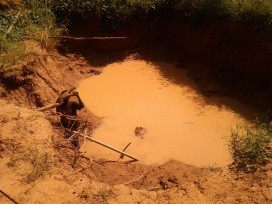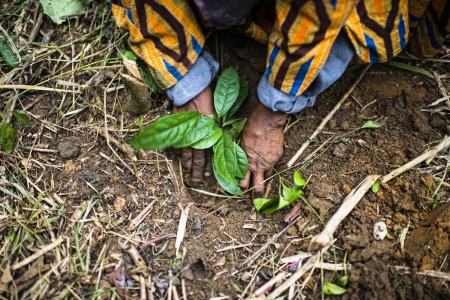This blog is part of the Agriculture and Ecosystems Blog’s month-long series on Ecosystem Services.
Dams are points in the landscape at which hydrological ecosystem services are realized or 'harvested' as hydropower, wild and farmed fisheries, urban water supply, irrigation water or a combination of these. There are more than 36,000 large dams in the world draining some 21% of the global land surface (Mulligan et al., 2009).
The Volta basin has many types of dam and reservoir, providing different services to a variety of first and next beneficiaries. The first beneficiary is the operator who receives income from selling the services or licenses to access the services of the reservoir. The next beneficiaries are the users of the services that are provided with new or improved livelihood opportunities from being able to buy into the services harvested.
But, dams create reservoirs which displace other land uses, deny agricultural productivity in the flooded land, secure water resources that are then no longer available downstream. They convert resources that were formerly tied up within the boundaries of tenured land into common pool resources of - for example - water and fish that can be more difficult to manage sustainably. Whilst rainfall onto land benefits all farmers, water in rivers and behind dams benefits only those who have access both economically and because of their proximity to the water body.
Building dams thus involves tradeoffs between the livelihoods supported by ecosystem services (rainfed farmers vs irrigators), between the services supplied (crops vs fisheries), between upstream and downstream users and between those whose access are provided by owning land to those who access is provided by having money. Sometimes these tradeoffs benefit the many and sometimes they benefit only a few: not all dams are equal (but some are more equal than others).
The Volta exemplifies a number of these tradeoffs at a range of scales. The CGIAR Research Program on Water Land and Ecosystems Volta Scoping Study that took place this last 9 days along a transect from Accra in Ghana to Kaya in Burkina saw many of these tradeoffs in evidence. We describe some examples in point below:
Akosombo, Ghana: capturing both ecosystem services and dis-services
The Akosombo holds back the largest man made lake in the world. It provides 80% of Ghana's electricity supply but its creation displaced 1% of the national population. It currently delivers significant ecosystem services (hydropower, fisheries, recreation) but also a series of ecosystem dis-services (increased incidence of diseases with water-borne vectors)
Kumasi, Ghana: reacting to changing circumstances
The Owabi dam was built in 1925 to supply the city of Kumasi. It now supplies only 20% of Kumasi's needs as the city now has a population of 2-3 million and has spread to cover almost all of the dam's catchment. The Owabi forest reserve around the dam acts to help secure the catchments water resources and prevent sedimentation but the reality is that with an almost entirely urban catchment the reservoir is now highly prone to sedimentation and the forest reserve is unlikely to affect this, though it likely does an effective job of reducing wastewater contamination.
The lesson? Circumstances change: just because a dam is built for water supply does not mean it has to always be so. Thinking more broadly through an ecosystem service lens perhaps it is better to let this reservoir fill with sediment as an urban wetland that forms part of the City's sanitation system and an urban recreational asset and focus resources that would have been used to dredge this reservoir on management of the dominantly rural catchment of the Barekese dam in the north to increase its contribution to supply from 80 to 100%.
Kaya, Burkina Faso: single large or several small
 Small-scale rainwater capture for irrigation near Kaya. Photo Credit: Mark Mulligan
Small-scale rainwater capture for irrigation near Kaya. Photo Credit: Mark Mulligan
Large dams are significant investments and produce common pool resources that are difficult to manage. Land use in the catchment of such dams can and does lead to their sedimentation. We heard from farmers in Kaya that the dam had filled up with sediment in the 80 years since their parents had dug it and it needed dredging.
But if dredged, wouldn't it just fill again? No, because the farmers know now not to farm upstream of it. These farmers had found a solution in the interim and maybe that is the best solution of all. They built many, small small ponds (2x7x5 metres) capturing runoff from grazed hillslopes and agricultural land in the wet season to be applied in the dry season. These do not fill with sediment, are close to fields and are more easily managed among small groups but they need to be located carefully in order to capture enough rain to last through the dry season. A knowledge of the spatial distribution of hydrological ecosystem services can help there.
Koubri, Burkina Faso: some dams are more equal than others
Dams change the supply and the distribution of ecosystem services. They can increase access to services but also increase the inequality of access. dams along rivers. At Koubri a series of dams along the Volta river pond water for irrigation and in the process have spawned a vibrant set of fisheries.
These dams are great sediment traps for material eroded from the river bed and banks as well as from the surrounding land. In flooding land to this extent, farmland is displaced by water. Its productivity is
sacrificed to increase productivity through irrigation of the land next to the dam, but whether the poorest farmers get access to this water depends on the costs of the water and the extent of distribution system put in place. The farmer's rainfed personal resource is replaced with a common pool resource that they must buy into by paying for water or fishing licenses.
Those with resources to invest may benefit more than those without meaning that building the dam wall and holding back the water is really just the first step to successful management of ecosystem services: the resulting water must have an extensive distribution system, widening access to it and serious consideration of how to reduce the inequalities that result must be built in to the management plan.
Dams are integrators of ecosystem services and the impacts of agriculture upon them. By capturing ecosystem services they change the distribution - spatially and socio-economically - of their beneficiaries. By looking at dams through an ecosystem service lens we can better understand their role in combining water, land and ecosystems to impact - and be impacted by - agriculture.
Related Posts on the Volta Scoping Study:
An ecosystem services lens helps integrate for resilient interventions supporting the poorest farmers of Ghana and Burkina Faso by Mark Mulligan
Sustainable aid: local interventions target landscapes to improve livelihoods by Fred Kizito
About the Author:
Mark Mulligan is Reader in Geography at King's College London and senior fellow of UNEP-WCMC. He led the CPWF Basin Focal Project for the Andes and the CPWF Phase II COMPANDES Project as well as cross-basin analyses of Water Availability and Climate Change
For updates follow us on @WLE_CGIAR and on Facebook.

















Comments
Agree very much with the need to adapt to changing circumstances, as the example in Owabi. We were just discussing earlier how some areas in the Volta are a lost cause in terms of agricultural investment, whether it be due to urban encroachment, top soil loss or increasing climate unpredictability.
Wonderful article! Very informative indeed. Farms can also benefit greatly by having their own dams and you can get more ideas about their uses here: https://mansfieldplanthire.com.au/mansfield/getting-farm-dam-construction....
Add new comment